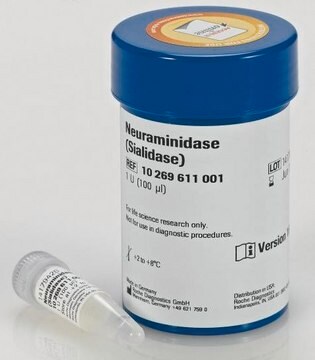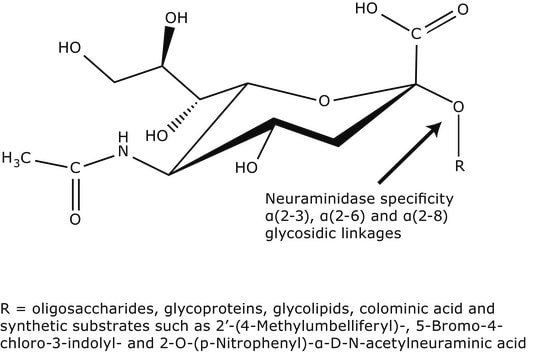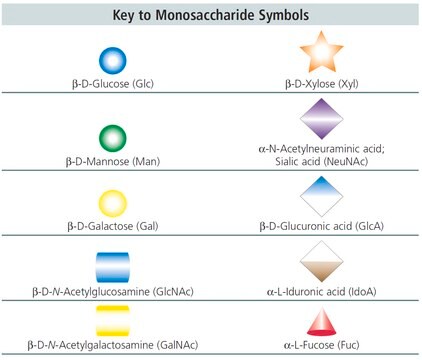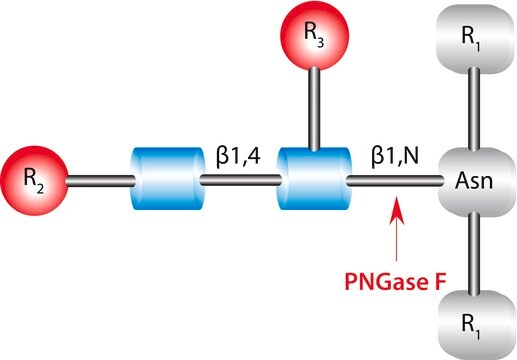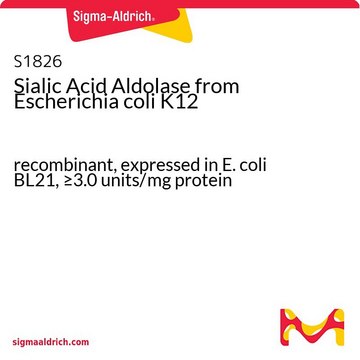Wszystkie zdjęcia(1)
Kluczowe dokumenty
N3786
α(2→3,6,8,9) Neuraminidase from Arthrobacter ureafaciens
Proteomics Grade, suitable for MALDI-TOF MS
Synonim(y):
Neuraminidase from Arthrobacter ureafaciens, Acyl-neuraminyl Hydrolase, Sialidase
Zaloguj sięWyświetlanie cen organizacyjnych i kontraktowych
About This Item
Polecane produkty
Formularz
lyophilized powder
Poziom jakości
jakość
Proteomics Grade
aktywność właściwa
≥25 U/vial
przydatność
suitable for MALDI-TOF MS
temp. przechowywania
2-8°C
Szukasz podobnych produktów? Odwiedź Przewodnik dotyczący porównywania produktów
Zastosowanie
Neuraminidase is an important deglycosylation enzyme capable of cleaving all non-reducing unbranched N-acetylneuraminic and N-glycolylneuraminic acid residues by hydrolysis of α(2→6), α(2→3), α(2→8), and α(2→9) linkages (affinity in the order given). Branched sialic acids may also be cleaved with the use of high concentrations of enzyme and prolonged incubations. Desialylated glycoproteins may then be further characterized by treatment with various exoglycosidases resulting in partial or complete O-deglycosylation. SDS-PAGE and MALDI-TOF MS are typically utilized in purification, structural analysis, and sequencing process. These techniques also remove heterogeneity and charge from the glycoprotein.
Opakowanie
Provided with 5× concentrate reaction buffer.
Jakość
The buffer solution has been specifically formulated to assure maximum enzyme stability and assay sensitivity.
Definicja jednostki
One unit will release 1 nmole of 4-methylumbelliferone from 2-(4-methylumbelliferyl) α-D-N-acetylneuraminic acid per minute at pH 5.5 at 37° C.
Postać fizyczna
Lyophilized powder
Ta strona może zawierać tekst przetłumaczony maszynowo.
Elementy zestawu są też dostępne oddzielnie
Numer produktu
Opis
Karta charakterystyki
- N3536Neuraminidase 5X Reaction Buffer 1.5 mLKarta charakterystyki
produkt powiązany
Numer produktu
Opis
Cennik
Hasło ostrzegawcze
Danger
Zwroty wskazujące rodzaj zagrożenia
Zwroty wskazujące środki ostrożności
Klasyfikacja zagrożeń
Resp. Sens. 1
Kod klasy składowania
11 - Combustible Solids
Klasa zagrożenia wodnego (WGK)
WGK 1
Temperatura zapłonu (°F)
Not applicable
Temperatura zapłonu (°C)
Not applicable
Wybierz jedną z najnowszych wersji:
Masz już ten produkt?
Dokumenty związane z niedawno zakupionymi produktami zostały zamieszczone w Bibliotece dokumentów.
Klienci oglądali również te produkty
Natallia Makarava et al.
Acta neuropathologica communications, 6(1), 92-92 (2018-09-14)
Last decade witnessed an enormous progress in generating authentic infectious prions or PrPSc in vitro using recombinant prion protein (rPrP). Previous work established that rPrP that lacks posttranslational modification is able to support replication of highly infectious PrPSc with assistance
Hongyun Li et al.
PloS one, 11(2), e0148238-e0148238 (2016-02-02)
Recent studies have shown that cerebral apoD levels increase with age and in Alzheimer's disease (AD). In addition, loss of cerebral apoD in the mouse increases sensitivity to lipid peroxidation and accelerates AD pathology. Very little data are available, however
Michael Worobey et al.
Nature, 508(7495), 254-257 (2014-02-18)
Zoonotic infectious diseases such as influenza continue to pose a grave threat to human health. However, the factors that mediate the emergence of RNA viruses such as influenza A virus (IAV) are still incompletely understood. Phylogenetic inference is crucial to reconstructing
Nenad Macesic et al.
The Medical journal of Australia, 198(7), 370-372 (2013-04-16)
To review cases of nosocomial influenza and compare the epidemiology, clinical characteristics and outcomes with community-acquired cases. Prospective case series of adults hospitalised with influenza during April - November of 2010 and 2011 using a hospital-based sentinel surveillance system. A
Dominic Meusch et al.
Nature, 508(7494), 61-65 (2014-02-28)
Tripartite Tc toxin complexes of bacterial pathogens perforate the host membrane and translocate toxic enzymes into the host cell, including in humans. The underlying mechanism is complex but poorly understood. Here we report the first, to our knowledge, high-resolution structures
Produkty
Glycan Sequencing Using Exoglycosidases
Nasz zespół naukowców ma doświadczenie we wszystkich obszarach badań, w tym w naukach przyrodniczych, materiałoznawstwie, syntezie chemicznej, chromatografii, analityce i wielu innych dziedzinach.
Skontaktuj się z zespołem ds. pomocy technicznej